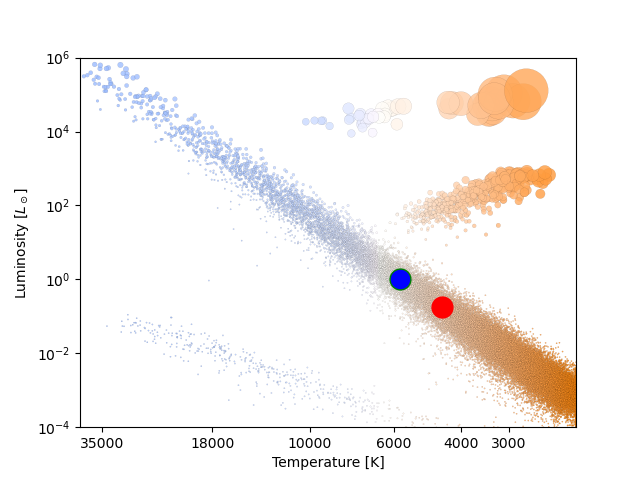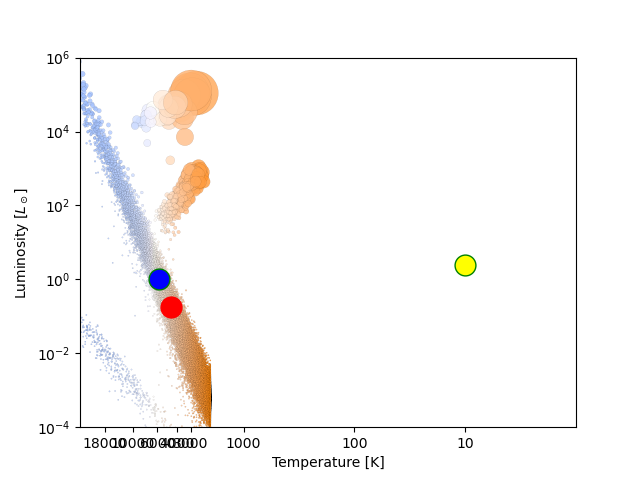Time to look at our star. We will be classifying our star, which can be done by determining the luminosity, after that we'll put our star in a diagram called HR diagram. After that we'll find how much time our star has left (exciting) and then we will see if the star has bee naughty (not well behaved). Then we'll see the formation of my star, the largest possible radius it could have had, and the estimated luminosity, exciting stuff up ahead letsssss go
I
We first determine the luminosity of our star using the Boltzmann equation 
we obtained a value of 6.68 *10^25, that's 0.174 the luminosity of the sun. So a pretty weak sun?
We then use our Temperature and Luminosity to plot on a HR-diagram, an HR diagram is just Luminosity plotted against temperature, nothing more nothing less, the more left you are the hotter, the higher up the more bright.

The red dot is my star and the blue dot is the sun, their size is obviously exaggerated.
Now to find the time left, stars with a high amount of mass end up burning through the fuel much much faster, one of the main reasons for this is the fact that they are more massive thus have greater gravitational forces which in turn cause high temperatures that lead to more fuel burnt. Our sun will spend around 10 billion years (on the main sequence) while if it was 10 times at massive it would've lived only for 20 million years, that is just insane. Note that because they use more fuel they are much more bright or luminous.
Using this relation we estimate the time left
.png) We combine the first line, and obtain a neat equation for Luminosity, but we can't jump the gun just yet, we must multiply 0.7% because that's how efficient the reactions are.
We combine the first line, and obtain a neat equation for Luminosity, but we can't jump the gun just yet, we must multiply 0.7% because that's how efficient the reactions are.
Is our star well behaved?
We see if the proportionally constants are similar, we use the following relations:
.png)
So the idea here is just to find the constant and compare, the first relation calculation yielded only 5.31% relative error! Wonderful!
We check the second relation, and we get 16.32% difference, a bit naughty but nothing tooooo crazy.
We check the third relation here
.png)
and we get 3.026% relative error, lets friggin goooooo, almost perfect!!
Giant molecular cloud
We'll assume that our star started as a spherically symmetric Giant molecular cloud with temp 10 K and 75% Hydrogen and 25% Helium, we'll assume that there are no shockwaves or radiation around that affects the collapsing process.
From virial theorem we have the equation that the condition that makes a cloud stable is that 2K > |U| (because the potential's sign is somewhat arbitrary), this means that that if 2K happens to be less than the absolute value of the potential energy, then our star will collapse KABOOM into a star. Using integrals and symmetries we can obtain an expression for the potential. Calculating the entire potential energy of a cloud will also give us the total mechanical energy. To calculate the total potential energy, consider the potential du of a small particle of mass dm inside the cloud at a distance r from the center. We know that the gravitational forces from a spherical shell of matter sum up to zero inside this shell (From dark matter lectures). As a result, we just need to examine the gravitational pull of the sphere of matter inside the mass's location on the mass dm. This is a sphere with a radius of r and a mass of M. (r). Newton's law of gravitation applies to a sphere as if it were a point mass in the center with mass M, similar to how we treat spherical charge distributions in electro magnetism. As a result, the potential energy between particle dm and the rest of the system is
.png)
Assuming spherical mass distribution (this means that at each point there is the same amount of mass), and thus constant density throughout, we arrive then at
.png)
We also know that the kinetic energy of a gas is given :
.png)
Going back to the condition, we insert for K and U that we found, with some changes such as writing out N in temrs of M and molecular mass, and solve for mass we get the following equation:
.png) Do you like my oversized mathematics?
Do you like my oversized mathematics?
Anyway, masses that are larger than this mass (we'll call it jeans mass from here on, even though it refers to a slightly different expression), we are interested in the radius so we solve for R and obtain
.png)
Where mu is given by
.png)
We get 2440.4 AU! We can use our luminosity equation again to find the luminosity of this cloud as it forms a star, and we get that our cloud is 10 times brighter! That's a bit weird, I would expect such low temperatures to not generate as much luminosity but I guess the radiation due to the convertion of the potential energy, it could very easily be a small mistake here or there tho, hella sus.
These clouds could take millions of years to collapse as the clouds get smaller and denser! The smaller the cloud, the more heat it produces (due to particle collisions), and when the core temperature of the collapsing star is high enough, nuclear fusion starts and a star is formed.
Assumption: There is no effect of magnetic fields or rotation or any other forces for that matter, this undermines how realistic our results are but wtv
_______________________________________
Nuclear reactions in my star's core
Assumptions
- Uniform density
- Pressure inside the star is gaseous pressure of an ideal gas (no radiation pressure)
- The interior of the star is in hydrostatic equilibrium (much more on this later in this scroll)
- The star consist purely of protons with a. given mass
Core temperature
To find an expression for the core temperature that allows us to look at the reactions and processes inside the star, we must start basic and first derive an expression for M(r) (mass as a function of position)
.png)
Then we use our assumption, number 3 and 2 and 1 to derive an expression for the temperature, then find the core temperature.
.png) Arrows and small explanations are included. Inserting the number we get the following:
Arrows and small explanations are included. Inserting the number we get the following:
3.6 * 10 ^6 K
Energy production and luminosity
Because our star has a core temperature of less that 90 * 10^6 we will assume the energy production in the core occurs via only PP and CNO cycles (and chains), we'll also assume we have 74.5% Hydrogen, 25.3% Helium and 0.2% Carbon, Oxygen and Nitrogen. All of this concentrated in a radius of 0.2R (R is the radius of our star), and here comes a physics malpractice charge, we'll assume uniform density and temperature throughout. To find how much energy is produced per second per kg we use the following expression
.png)
Where the pp chain has this expression
.png)
The CNO-cycle has the following expression describing it
.png)
Inserting the percentages we got in both expressions we get
3.76 x 10 ^-5
Calculating the luminosity :
We can use a known relation
.png)
Which gives us 1.37 x 10^28
this is 208 times larger than the value we obtained earlier using the Boltzmann relation, this is surely beause we assumed constant density and constant temperature throughout, the other relation does not need such malpractices of assumptions. On the HR diagram it's here 
All in all, we're satisified with the results, we always came close to what is expected and our star is not naughty!! Next we look at the death of our nice star.